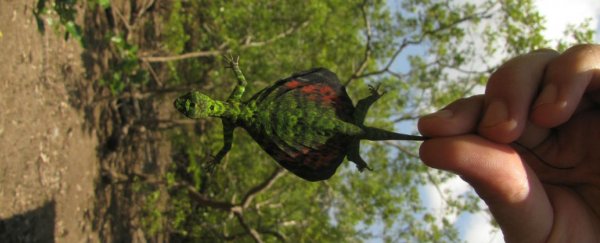Gliding lizards in Borneo – a large Southeast Asian island – might be avoiding avian predators by mimicking the colour of falling leaves in the forests they call home, a new study suggests.
Interestingly, the lizards (Draco cornutus) have also learned to fall like leaves – a behaviour that might further deceive birds of prey.
"The pattern of movement of falling leaves is extremely variable, but commonly includes a gliding motion akin to the directed gliding in Draco," wrote lead author and PhD candidate Danielle Klomp, and her colleagues from the University of Melbourne and the University of New South Wales in Australia.
Commonly referred to as flying dragons, these lizards have skin membranes that extend out from their torsos, like wings, which help them glide between trees.
New research, published this week in Biology Letters, suggests that populations of the lizard in Borneo have evolved colourful markings on these gliding membranes, which are nearly identical to the colour of falling leaves from trees local to their habitat.
An Australian and Malaysian research team travelled to Borneo and observed two populations of the gliding lizard, recording more than 30 hours of video footage. Each population inhabited a starkly different habitat on the island, and also had different colour markings on their gliding membranes.
According to the team's observations, one population had narrow, red – almost rust-coloured – markings, which closely matched the shape and colour of the falling red leaves from their coastal mangrove forest habitat. The other population had dark brown and green membranes, which matched the falling leaves in their lowland rainforest habitat.
Part of their research involved determining how the colours would be perceived by birds, which can see ultraviolet light in addition to the colours perceived by humans. Their finding, according to the press release, is that the gliding membrane colour would be "indistinguishable from a falling leaf in the same forest".
"It's a cool finding because these gliding lizards are matching the colours of falling leaves and not the leaves that are still attached to the tree," said Klomp in the press release.
"In the mangrove population the leaves on the trees are bright green, but turn red shortly before falling to the ground, and it is this red colour that the lizards mimic in their gliding membranes. This allows them to mimic a moving part of the environment – falling leaves – when they are gliding," she said.
"Perhaps these populations may have originally had the same gliding membrane colours but as they have moved into different forest types their colours have adapted to closely resemble the colours of falling leaves in the different forests, known as divergent evolution."
The team was also interested in whether the gliding membranes were used for display, or as a means of communication with possible mates, as other researchers have hypothesised. Their footage, however, rarely showed this type of behaviour..
But, as science writer Ed Yong points out in his National Geographic blog, there is other video evidence suggesting that these membranes are in fact used for communication:
Find out more about the world-leading research happening at UNSW.
Source: EurekAlert
